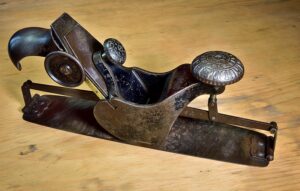
We often have Stanley No. 113 circular planes also known as compass planes in the shop along with the Stanley No. 20s and Record planes.
This particular plane was unusual in its curvature adjustment so thought it would be of interest for vintage tool historians and collectors.
As its a USA made plane I wrote it up for one of the American collectors interest groups.
Published in Mid-West Tool Collectors Association monthly publication “The Gristmill” issue No. 186 March 2022, p. 26 & 27
Stanley No. 113 Circular Plane with unusual locking mechanism
OK we see a lot of tools going through the shop and sometimes one comes in which seems a bit unusual. We get a reasonable number of compass / circular planes of various vintages just not like this.

The front knob is used to change the curvature of the flexible sole.
In the early models, types 1 (1877 to 1880) and 2 (1880 to 1891), holding the front knob when using the plane can cause it to accidentally rotate thus changing the curvature. This problem was recognized by Stanley and the plane was changed to incorporate a split in the casting and a set screw which could lock the adjustment knob.
Our unusual 113 plane is a type 2 in most respects. It has the “Stanley Rule Level Co.” and “Patented September 25,1877 in a circular border on the adju

ster knob but not the central decorative “maze” design.

The blade adjuster has the single hole,
the side adjustment wheel has the 4 holes; not the solid design. The small hinge plates front and back of the sole are simple rectangular shapes; not the decorative pointed shapes. It has the June 17, 79 patent on the dovetailed keys sole attachment plate and the sole is attached by swaging the rivets not screws. The rear handle is held by one bolt.
The unusual aspect of this plane is a very different method of locking the curvature.

Under the rear handle the frog casting has an added vertical flange. T

his flange has bolted to it a steel plate with two curved slots cut in it. Behind this plate is a second plate with a bolt which goes through the forward of the two curved slots and has its own curved slot exactly under the back slot of the top plate. The bolt has a washer and wing nut to lock the two plates together. The rear sole plate strut also has a bolt attached which goes through the second curved slot in both plates and again has a washer and wing nut to lock the strut to the plates. Best seen in the photographs.
This mechanism allowed the front and back soles to curve equally on adjusting the front knob and to solidly lock the curvature in place. It could also allow the back sole to have a slightly different curve if wanted.
This particular plane seems all in excellent condition and no markings or numbers indicating it could be a model shop version which found its way to England, but could it be from the model shop? Could it be a user modification of a standard 113 plane? It’s certainly seems a manufactured item as the cast iron frog isn’t just cobbled together, the wing nuts well done, the Japanning looks original. The iron is virtually full length with the “STANLEY RULE & LEVEL CO.” “NEW BRITAIN.CONN.USA” “PATT. APRIL 18 & 28, 76”, again seeming original.
The blade cap iron is stamped L Bailey Patent APR 23 1867 Dec 12 1876, The dovetail holding the base in place is stamped PATD JUNE 17, 79. No other marking seem to exist on the plane. It’s lever cap is the Bailey Cam Lock type and the iron has the closely spaced row of holes which the geared depth adjustment engages with.
We are not sure about the origins of this method of locking the sole, but the clean little used condition with traces of black japanning we suspect it was at the cusp of the Stanley Bailey merger between types.
In use the curvature adjustment and lock is very positive. The cap iron cam lock is a real joy, simple and positive. The blade depth adjustment is very smooth and precise while still allowing a small amount of lateral movement.
As a brief comparison photographs of a type 1

and a later type are included.

On the theme of circular planes the other dominate pattern is the Bailey “Victor” No. 20 compass plane with curvature adjusted by central threaded shaft. An example of a less usual earlier one is illustrated here. It’s possible this is simply the Stanley version without the front and rear medallions, but even though those were only held on by simple bolts there no indications that this plane ever had such medallions. So is this a plane from pre Stanley acquisition of Bailey or a modified version of the Stanley Bailey “Victor” No. 20?
Some references if interested:
Details about some of the changes on the Stanley No. 113 Circular Plane
Stanley No. 113 Circular Plane, a bit more
Stanley Compass Plane – No. 113 and a bit about using it
This links to Patrick’s Blood and Gore discussion on Stanley planes more generally but including the 113. Really good general reference.